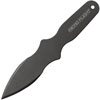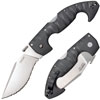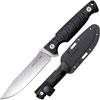|
|
|
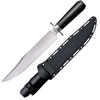 |
|
| Knife Cold Steel Laredo Bowie (4043SS) (39LME4) |
|
Awesome is the only adjective that even begins to describe the Cold Steel Laredo Bowie. In fact, it really has to be seen to be appreciated, since mere words just don't do it justice. It features a long, heavy blade made from 4034SS stainless steel, which is flat ground to produce incredible cutting power and perfect balance. And, as an added bonus, it is given an absolutely ferocious cutting edge that terminates in a dagger-sharp point.
|
|
|
|
|
|
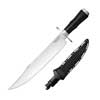 |
|
| Cold Steel Natchez Bowie (4034SS) (39LMB4) |
Points: 20
|
"Under-The Hill" was the notoriously rowdy riverfront district of Natchez, Mississippi at the beginning of the nineteenth century. So disreputable, it was seldom mentioned in the polite drawing rooms of the antebellum mansions that dotted the other side of town during the era when cotton was king.
Our Natchez Bowie was born "Under-The-Hill" and takes its pedigree from those seedy taverns and dimly lit streets. Line-bred for battle, it's the definitive fighting Bowie. Its long blade is perfectly shaped for strength, reach and leverage, and its significant heft is flawlessly balanced, giving it unparalleled liveliness and velocity. Combine all that with its wickedly razor sharp edge and you have a knife that pierces like a dagger, cuts like a razor and chops like a cleaver! Blade is made of 4034 stainless steel. Micarta handle, includes SecureEx sheath.
|
|
|
|
|
|
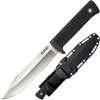 |
|
| Knife Cold Steel SRK (CPM 3V) (38CKE) |
Points: 10
|
Cold Steel 3V SRK knife. Survival & Rescue operations demand a versatile knife able to withstand the most extreme conditions. Simply put, the Cold Steel SRK (Survival Rescue Knife) was designed specifically with this in mind. A popular knife with Military and Tactical Law Enforcement Personnel, the SRK is the standard issue knife of the Navy SEALS for their BUDS - or Basic Underwater Demolition training - the SRK has proved its worth time and time again in the most demanding environments. Whatever the mission, we’re confident that the SRK is the knife for you!
|
|
|
|
|
|
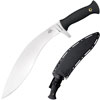 |
|
| Cold Steel Gurkha Kukri Plus (CPM 3V) (35GKP) |
Points: 20
|
The Gurkha Kukri Plus’ CPM-3V tool steel blade will out-chop any factory or handmade knives; including swords twice its size, even expensive, hand-forged Japanese Katanas. It’s the heaviest Kukri on the market. The blade is almost an inch wider near the tip than at the handle, shifting the knife’s balance point forward to allow a substantial blow to be struck with minimal effort, using inertia alone to complete the cut.
|
|
|
|
|
|
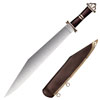 |
|
| Viking Sword Sax Blade Knife (88HVA) |
Points: 10
|
If you've got warrior blood in your veins, then we have two weapons youre bound to love. The Damascus Viking Sword and its companion, Long Sax are hand forged from our finest Damascus steel and come fully sharpened and ready for battle.
|
|
|
|
|
|
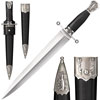 |
|
| Cold Steel Arkansas Toothpick Knife (88GTP) |
Points: 10
|
The main competition to the Bowie knife from the late 1830's to the period just after the Civil War was the Arkansas Toothpick. The Arkansas Toothpick got its namesake as an ironic reference to the coarse, rough and tumble culture that populated the lowlands of Arkansas and the Mississippi delta in the mid 19th century.
|
|
|
|
|
|
 |
|
| Cold Steel Knife Razor Tek 5 (FX-5RZR) |
Points: 3

|
The next step up in the Razor Tek series features a 5 inch recurve blade. A recurve blade gives the benefits of a longer cutting edge and belly at the front. This blade shape offers the benefits of cutting when drawing or pulling the blade through.
|
|
|
|
|
|
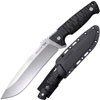 |
|
| Cold Steel Knife Razor Tek 6,5 (FX-65RZR) |
Points: 10

|
The next step up in the Razor Tek series features a 5 inch recurve blade. A recurve blade gives the benefits of a longer cutting edge and belly at the front. This blade shape offers the benefits of cutting when drawing or pulling the blade through.
|
|
|
|
|
|
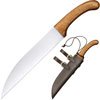 |
|
| Cold Steel Woodsman's Sax (88HUA) |
Points: 3
|
Like some historical saxes that have survived, the Woodsman’s features a stout 11” long blade with the characteristic sloping point and an unadorned wooden handle made from exotic imported hardwood.
|
|
|
|
|
|
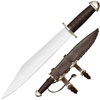 |
|
| Cold Steel Chieftan Sax (88HUK) |
Points: 5
|
Since the Chieftans Sax is meant to be a weapon first and a tool a distant second it comes with a modestly sized brass guard that serves to keep the fingers from sliding forward on to the blade while offering a modicum of protection from opposing weapons.
|
|
|
|
|
|
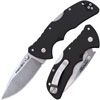 |
|
| Cold Steel Mini Recon 1 Spear Point 10A Stone Wash (27BAS) |
|
The Cold Steel Recon 1 series stands out as a popular collection of knives favored by a diverse range of users including law enforcement officers, military personnel, rescuers, and civilians who prioritize accurate and dependable tools. The reintroduction of the mini model includes an updated handle crafted from injection molded plastic featuring a textured surface that enhances grip even in challenging conditions. The ergonomic design of the handle ensures a seamless fit in the hand, facilitating comfortable and efficient work.
|
|
|
|
|
|
 |
|
| Cold Steel Mini Recon 1 Tanto Point 10A Stone Wash (27BAT) |
|
The Cold Steel Recon 1 series stands out as a popular collection of knives favored by a diverse range of users including law enforcement officers, military personnel, rescuers, and civilians who prioritize accurate and dependable tools. The reintroduction of the mini model includes an updated handle crafted from injection molded plastic featuring a textured surface that enhances grip even in challenging conditions. The ergonomic design of the handle ensures a seamless fit in the hand, facilitating comfortable and efficient work.
|
|
|
|
|
|
|
|
Tags:
swords, sword, katana, wakizashi, tanto, japanese sword, medieval sword, viking sword, japanese swords, medieval swords, viking swords, knife, knives, saber, armour, movie swords, movie replicas, martial arts, sporting goods, sporting equipment,
|

